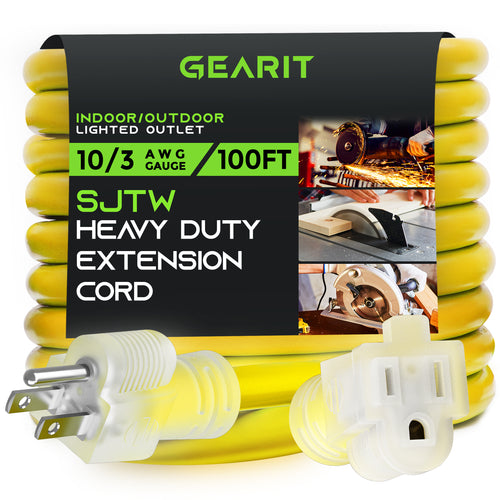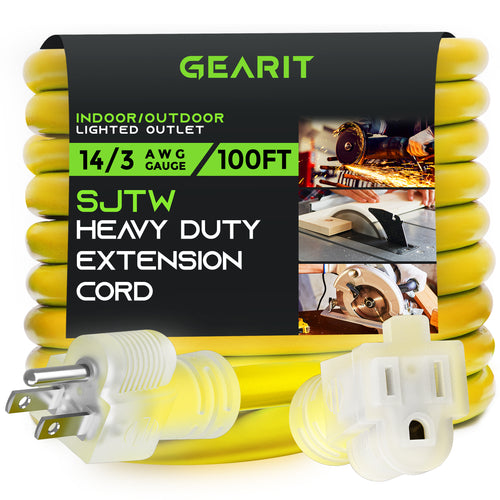
Understanding a power cord types chart can make choosing the right cord much easier for your needs. Whether it's for electronics, appliances, or other applications, knowing the different power cord types is essential.
These charts break down the electrical connections required for various devices, helping you ensure compatibility and safety.
By familiarizing yourself with the chart, you can confidently select the right power cord for all your gadgets and appliances.
What is a Power Cord?
GI-EXT-L
A power cord is a cable that helps deliver electricity from an outlet to an electrical device. Many appliances, like computer monitors, dryers, and electric ranges, use power cords. On one end, you'll find a molded plug to connect to an outlet. The other end has either bare wires or a socket for the device.
Understanding different types of power cords is crucial for both safety and functionality:
-
Safety: Choosing the right cord ensures that the device operates safely without risks of overheating or electrical hazards.
-
Functionality: Different appliances require specific cords for optimal performance, so using the right one is essential.
-
Durability: Thick and well-insulated cords can withstand wear and tear better, making them last longer and perform effectively.
Knowing these aspects can help you choose the right power cord for each of your devices and keep them running safely and efficiently. For more details, check out this What Is a Power Cord?
When choosing a power cord, you should pay attention to factors like the cord's length, thickness, and material. The length affects where you can place the device, while thickness and material determine how well the cord can handle the electrical load and environmental conditions.
Having the right power cord is more than just a convenience; it’s a key part of ensuring your electronic devices work correctly and last as long as possible.
Power Cord Types Chart: Common Plug and Connector Types
Understanding power cord types is essential for choosing the right connection. The following chart includes some of the most common plug and connector types to help you.
NEMA Power Cords
🛒 50 Amp NEMA 14-50 Heavy Duty Extension Cord Power Cord
-
Type A: Two flat blades, widely used in North America.
-
Type B: Two flat blades and a grounding rod, offering additional safety.
-
For more on NEMA standards, you can check this NEMA Connector Chart Guide.
IEC Power Cords
-
C13 to C14: Commonly used for computer and electronic equipment.
-
C15 to C16: Often found in high-temperature environments.
You can learn more about these with this NEMA vs. IEC article.
Regional Variations
-
Schuko (Europe): Known for its round design and grounding features.
-
BS 1363 (UK): Features three rectangular pins.
|
Cord Type |
Connector Example |
Region |
Photo |
|
NEMA Type A |
Two flat blades |
North America |
|
|
IEC C13/C14 |
Electronics/Computers |
Global |
|
|
Schuko |
Two round pins |
Europe |
|
Taking the time to become familiar with these common power cord types allows you to make informed choices when working with electrical connections.
Explore our collection of Power Extension Cords and find the perfect solution to keep your devices connected and powered up anywhere!Check out our Power Extension Cord
Types of Power Cords: Series and Variations
The world of power cords includes various types and series, each serving specific needs. Understanding these helps you select the right cord for your devices.
This section covers the key series: NEMA, IEC, and CEE, explaining their features, typical uses, and where they're commonly found.
NEMA Power Cords
Photo: https://www.americord.com/nema-charts
NEMA power cords are widely used in North America. These cords follow the National Electrical Manufacturers Association standards. You often find them in home appliances and industrial equipment. NEMA connectors have different pin configurations, each suited for unique power requirements.
-
Applications: They are frequently used in residential lighting, HVAC systems, and large appliances.
-
Voltage and Amperage: They typically support up to 125 volts and vary from 15 to 60 amps depending on the type.
-
Regions: Primarily used in the United States and Canada.
Each NEMA plug and connector is labeled with a number and letter combination, like NEMA 5-15 or NEMA L6-30, indicating its specific use. Understanding these codes is crucial when selecting a NEMA cord for your device.
IEC Power Cords
IEC power cords are global standards set by the International Electrotechnical Commission. These are common in computer equipment, servers, and business machines.
The typical designation you might see is IEC 60320, which covers several connector types, like C13/C14 and C19/C20.
-
Applications: Used for computers, monitors, and similar electronics.
-
Voltage and Amperage: They support up to 250 volts and various amperages.
-
Regions: Used worldwide, including Europe, Asia, and North America.
IEC cords are known for their versatility and safety features. Both ends of these cables can have different configurations, allowing for broad uses in various equipment setups.
CEE Power Cords
CEE power cords are based on standards set by the International Commission on Rules for the Approval of Electrical Equipment (CEE). These cords are predominantly used in European markets for industrial and commercial applications.
-
Applications: Common in industrial machinery and high-power equipment.
-
Voltage and Amperage: They handle higher voltages and amperage, typically up to 400 volts.
-
Regions: Primarily used in Europe, including countries like Germany and France.
These cords are robust and often equipped with waterproof and dustproof features, making them ideal for harsh environments. Understanding the specific needs of your equipment is key when selecting a CEE cord.
Safety Tips for Using Power Cords
Using power cords safely is crucial to prevent accidents and damage. Here are some key tips to keep in mind:
-
Check for Damage: Always inspect power cords for cuts, frays, or exposed wires. Using damaged cords increases the risk of fire and electric shock.
-
Proper Installation: Make sure cords are plugged in securely to both the outlet and the device. Loose connections can create sparks or shorts.
-
Avoid Overloading: Do not exceed the voltage and wattage limits specified for your power cords. For instance, using a 125-volt cord on a 250-volt appliance can be dangerous.
-
Keep Away from Water and Heat Sources: Ensure cords are dry and placed away from sinks, bathtubs, stoves, or heaters to avoid risks of electrocution or overheating.
-
Use Certified Products: Look for UL certification on cords. This indicates they have been tested for safety standards (UL certification indicates).
-
Don't Force Plug Fit: Forcing a plug into a mismatched outlet can damage the cord or outlet and create a potential fire hazard.
-
Unplug When Not in Use: If you won't be using a device for a long time, unplug the cord to minimize hazards (Unplug cords).
-
Proper Storage: When storing, coil the cord loosely to prevent bending, which can damage wires inside.
Plug Types and Socket Compatibility
Understanding plug types is essential when dealing with electrical devices, especially when traveling or using international appliances. Different regions have standardized plug types, and plug compatibility varies around the world, often requiring adapters or converters.
Type A and Type G Plugs
-
Type A plugs are commonly used in North America and Japan. They have two flat parallel prongs and are designated by the standard NEMA 1-15. They are suitable for non-grounded devices and typically provide 15 amps at 125 volts. It's essential to ensure the plug fits into the sockets of the region you are in.
-
Type G plugs are used primarily in the United Kingdom, Ireland, and other regions that follow the British standard. These plugs have three rectangular prongs forming a triangle, providing a grounding mechanism. They are designed for up to 13 amps at 230 volts. Make sure your devices are compatible or use an appropriate adapter if necessary.
International Plug Types and Socket Standards
Plug types and socket standards vary globally, leading to challenges when using devices internationally. For instance, the CEE 7/7 plug combines compatibility for both the standard German and French grounded socket systems. It supports a higher voltage and current.
Other regions use formats like AS/NZS 3112 in Australia and New Zealand, which have angled, flat prongs. NBR 14136 refers to the Brazilian standard, featuring specific prong configurations. Understanding these standards helps in selecting the right adapters for your devices.
Conclusion
Understanding the different power cord types and plug variants is essential for ensuring compatibility and safety, whether you're traveling or setting up devices at home. With this guide, you can confidently choose the right cords for your needs, from everyday use to specialized equipment.
For top-quality solutions, check out our premium collections of Multi-Plug Extension Cords and NEMA 30 Amp Plugs. Designed for reliability and performance, these products are perfect for various applications.
Don’t wait—shop now and power up with confidence!
Frequently Asked Questions
Power cords vary in design, voltage ratings, and type codes. Understanding these aspects helps ensure compatibility and safety when connecting devices to power sources. Below are some common questions answered about power cords.
What’s the difference between NEMA and IEC power cords?
NEMA power cords are used primarily in North America and have different configurations based on voltage and amperage requirements. In contrast, IEC power cords have international standards, making them more versatile in various global applications.
How do I identify the voltage rating of a power cord?
You can usually find the voltage rating printed on the cord itself. Look for numbers followed by "V" which indicates volts. This rating is crucial to ensure your power cord matches the electrical requirements of your device.
What is a type B power cord?
Type B power cords have a grounded plug with two flat parallel pins and one round grounding pin. These cords are common in the United States and are used for devices requiring grounding for safety.
What is a C19 power cord?
A C19 power cord features a high current rating, making it suitable for data center equipment like servers. It has a rectangular shape and a connector with horizontal mounting for secure connections.
What is a standard power cord?
A standard power cord generally refers to those used with most household electronics and appliances. They often have a two-pin or three-pin configuration depending on grounding needs and comply with local electrical standards to ensure safety.
Relate Articles to Read 📖:





















































